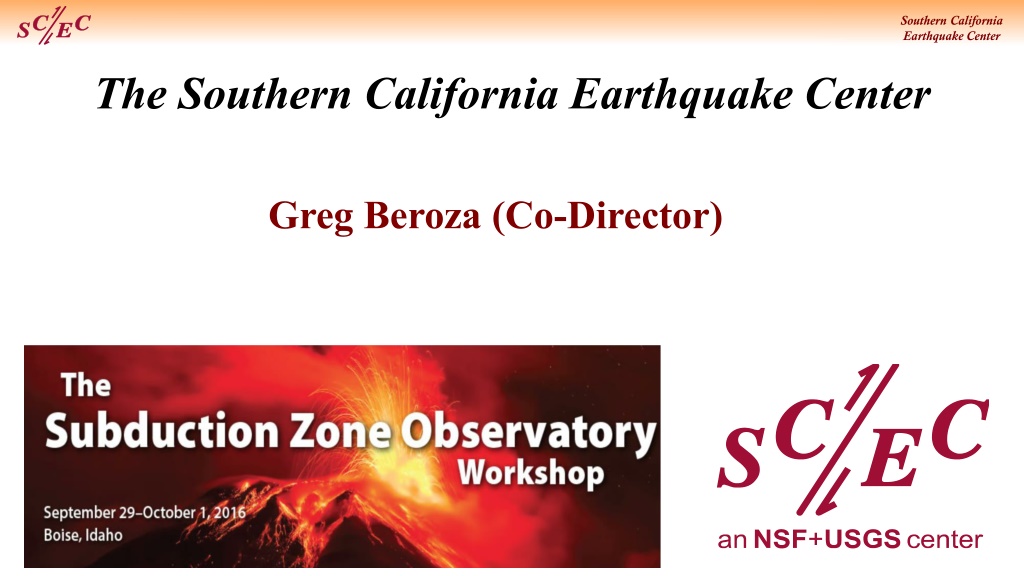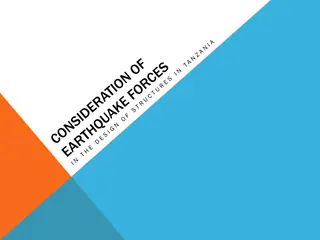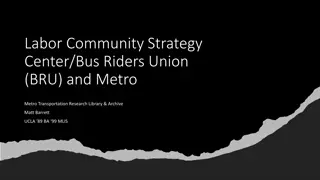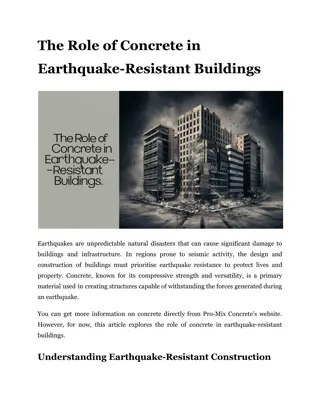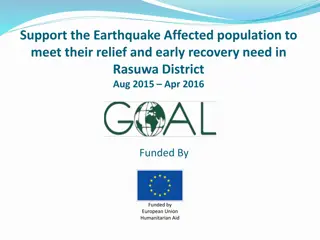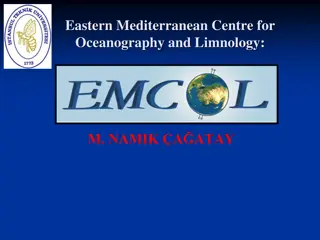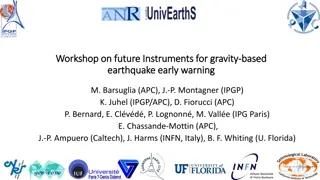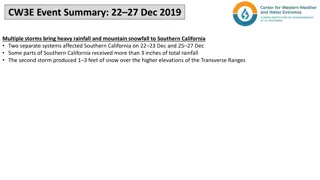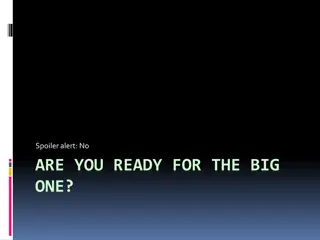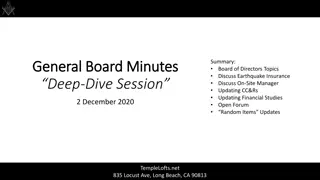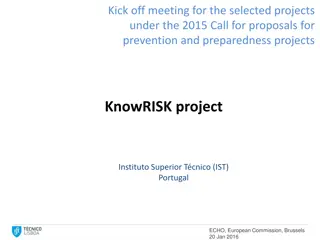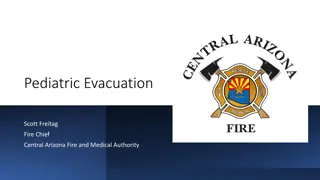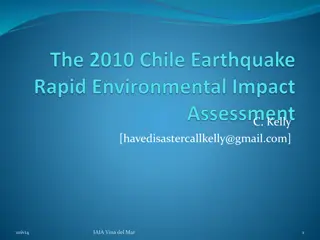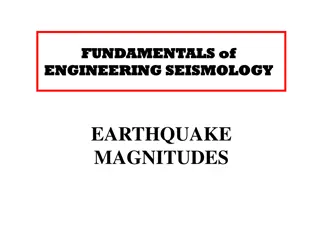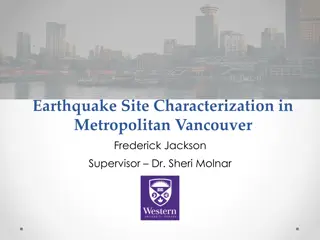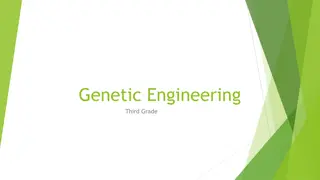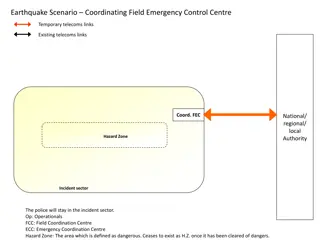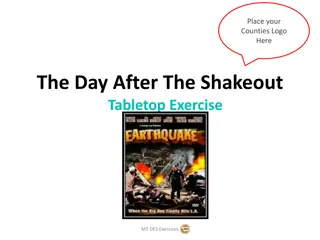Southern California Earthquake Center Overview
The Southern California Earthquake Center (SCEC) is a large consortium of institutions dedicated to coordinating earthquake research in Southern California. Their mission involves communicating earthquake understanding to reduce risk and improve community resilience, integrating information for a comprehensive understanding of earthquakes, and gathering earthquake data locally and beyond. SCEC serves as an interdisciplinary collaboratory focusing on system-level earthquake processes and operates as a natural earthquake laboratory due to the tectonic diversity of faulting in the region. With a well-instrumented environment and advanced research capabilities, SCEC plays a crucial role in earthquake research and risk reduction efforts.
Download Presentation

Please find below an Image/Link to download the presentation.
The content on the website is provided AS IS for your information and personal use only. It may not be sold, licensed, or shared on other websites without obtaining consent from the author. Download presentation by click this link. If you encounter any issues during the download, it is possible that the publisher has removed the file from their server.
E N D
Presentation Transcript
Southern California Earthquake Center The Southern California Earthquake Center Greg Beroza (Co-Director)
Southern California Earthquake Center Southern California Earthquake Center Large consortium of institutions that coordinates earthquake research in Southern California SCEC Mission: 3. Communicate understanding to end-users and society at large as useful knowledge for reducing earthquake risk and improving community resilience 2. Integrate information into a comprehensive, physics-based understanding of earthquake phenomena 1. Gather data on earthquakes in Southern California and elsewhere 9/24/2024 2
Southern California Earthquake Center SCEC4 Core Institutions (Sept 1, 2016) Core institutions: 18
Southern California Earthquake Center SCEC4 Participating Institutions (Sept 1, 2016) Domestic institutions: 44
Southern California Earthquake Center Total SCEC Funding $14.0 SCEC Total Funding Annual Funding ($M) $12.0 CEO Projects $10.0 Special projects (41%) Institutions (21%) 2002 Dollars $8.0 Special Projects $6.0 Inst Cost Share $4.0 USGS Core Core program (38%) $2.0 NSF Core $0.0 2002 2003 2004 2005 2006 2007 2008 2009 2010 2011 2012 2013 2014 2015 2016 Institutional match stays at institution = leverage Special projects must align with core program to enable open participation.
Southern California Earthquake Center Southern California Earthquake Center Large consortium of institutions that coordinates earthquake research in Southern California Interdisciplinary collaboratory that synthesizes and validates system-level models of earthquake processes SCEC Mission: 3. Communicate understanding to end-users and society at large as useful knowledge for reducing earthquake risk and improving community resilience 2. Integrate information into a comprehensive, physics-based understanding of earthquake phenomena 1. Gather data on earthquakes in Southern California and elsewhere 9/24/2024 6
Southern California Earthquake Center Southern California as a Natural Earthquake Laboratory Tectonic diversity of faulting Well instrumented and mapped Right scale for system-level earthquake research SCEC Unified Structural Representation (USR) [Shaw et al., 2015] High-risk environment with a population of over 23 million Comprises 40% of the national annualized earthquake risk Proving ground for new risk-reduction technologies Earthquake early warning & operational earthquake forecasting Performance-based design 9/24/2024 7
30-yr BPT probability Southern California Earthquake Center event likely Southern California as a Natural Earthquake Laboratory 8 7 UCERF3 Paleoseismic Data for Selected Sites 5 6 Tectonic diversity of faulting Well instrumented and mapped Right scale for system-level earthquake research 2 1 34 9 10 event unlikely High-risk environment with a population of over 23 million Comprises 40% of the national annualized earthquake risk has been near a supercycle minimum? What are the seismic hazard implications? Are seismic supercycles real? Do long open intervals imply that California RSQsim (Dieterich & Richards-Dinger, 2010) 50% Proving ground for new risk-reduction technologies Earthquake early warning & operational earthquake forecasting Performance-based design 100-yr Moving Average of Seismic Moment Release from Simulators 200 yr ALLCAL (Ward, 2008) 50% 200 yr Years (arbitrary origin) 9/24/2024 8
Southern California Earthquake Center Jackson s Conundrum Most recent event 1906 1857 1868 1910 1769 1605 Poisson rate, lamda 0.00944 0.00940 0.00572 0.00513 0.00374 0.00296 0.00264 0.00142 0.00079 0.00041 0.00027 0.00015 Poisson Survival 1910 - 2014 0.375 0.376 0.551 0.586 0.678 0.735 0.760 0.863 0.921 0.959 0.972 0.985 Lognormal Survival 1910 -2014 0.3521 0.2289 0.5339 0.8363 0.6509 0.5494 0.6269 0.7604 0.9134 0.9481 1.0000 0.9927 s s mu 12 sites, selected out of 32 sites as being independent (not sharing any earthquake ruptures) Index Site 14 N._SAF Santa_Cruz_Segment 32 S._SAF Wrightwood________ 11 Hayward_Fault South 3 Elsinore Glen_Ivy 21 San_Jacinto Hog_Lake 9 Green_Valley Mason_Road 20 Rodgers_Creek 1708 1 Calaveras_Fault North 8 Garlock Western_(all_events) 2 Compton 18 Puente_Hills 12 Little_Salmon Strong's_Creek 1.90 1.93 2.18 2.21 2.25 2.39 2.40 2.71 2.91 3.21 3.52 3.51 0.80 0.65 0.45 0.45 1.07 0.60 0.70 0.62 0.90 1.00 0.30 1.71 1290 1682 803 1762 -8878 Ensemble 0.04207 0.013 0.0053
Southern California Earthquake Center System-Level Simulations Currently 11 sites past UCERF3 MRI. RSQSIM tuned to UCERF3 MRI indicates P < 0.07%
Southern California Earthquake Center Southern California Earthquake Center Large consortium of institutions that coordinates earthquake research in Southern California Interdisciplinary collaboratory that synthesizes and validates system-level models of earthquake processes Open community of trust that shares data, models, knowledge & ideas, as well as responsibility for educating future generations SCEC Mission: 3. Communicate understanding to end-users and society at large as useful knowledge for reducing earthquake risk and improving community resilience 2. Integrate information into a comprehensive, physics-based understanding of earthquake phenomena 1. Gather data on earthquakes in Southern California and elsewhere 9/24/2024 11
Southern California Earthquake Center SCEC Annual Meeting 707 pre-registrants 347 poster abstracts 211 first-time attendees (145 students/postdocs) 395 early-career attendees o 234 students o 59 postdocs SCEC has an annual meeting for research coordination. It features a small number of plenary talks, science planning sessions, and dedicated time for poster sessions and nucleation of new collaborations among small groups.
Southern California Earthquake Center SCEC5 Science Planning Organization SCEC Administration PC Chair & Vice-Chair Planning Committee WGCEP Geology FARM Disciplinary Committee Focus Group UGMS TAG CME Geodesy SDOT Disciplinary Committee Focus Group Special Projects GMSV TAG Seismology Disciplinary Committee EFP CSEP EEII Focus Group Comp Science Disciplinary Committee SAF System Focus Group CISM NHERI Partnerships CCSP CXM Working Group SFSA Working Group SFSA1 TAG USR TAG CRM TAG EG1 TAG SFSA2 TAG CSM TAG CTM TAG EG2 TAG SFSA3 TAG CGM TAG
Southern California Earthquake Center Unified Structural Representation (USR) Community Models Established targets for boundaries, depth, resolution Alternative models/representations Easy access for spectrum of users Versioned releases Different representations (grids, surfaces, rules) Shaw et al., (2015) Leverage cyberinfrastructure (standardized APIs & storage)
Southern California Earthquake Center Technical Activity Groups (TAGS) Develop and test critical methods for solving specific forward and inverse problems. TAGs typically involve: Posing carefully defined standard problems Solving them by different researchers with different approaches Virtual/in person meetings to compare solutions, discuss discrepancies, and work on improvements Archiving results for future use.
Southern California Earthquake Center Technical Activity Groups (TAGS) Earthquake Simulators: use approximate, multi-cycle earthquake simulations to develop long-term synthetic earthquake catalogs to inform earthquake forecasting. (Terry Tullis) Source Inversion Validation: understand reliability, uncertainty, and non- uniqueness for finite-fault source inversions. (Pablo Ampuero) Ground Motion Simulation Validation: test the predictive value of ground motion simulations against data and ground motion prediction models. (Nico Luco & Sanaz Rezaeian) Transient Detection: develop aseismic deformation transient detection algorithms and to apply to continuous geodetic data. (Rowena Lohman and Jessica Murray)
Southern California Earthquake Center Southern California Earthquake Center Large consortium of institutions that coordinates earthquake research in Southern California Interdisciplinary collaboratory that synthesizes and validates system-level models of earthquake processes Open community of trust that shares data, models, knowledge & ideas, as well as responsibility for educating future generations Reliable partner that works with many other organizations to reduce risk and promote earthquake resilience SCEC Mission: 3. Communicate understanding to end-users and society at large as useful knowledge for reducing earthquake risk and improving community resilience 2. Integrate information into a comprehensive, physics-based understanding of earthquake phenomena 1. Gather data on earthquakes in Southern California and elsewhere 9/24/2024 17
Southern California Earthquake Center 2015 ShakeOut Earthquake Drills States, Territories, Provinces & Countries Participating in the 2015 Great ShakeOut Earthquake Drills 2015 Official ShakeOut Regions 28 Regions worldwide 22 U.S. regions spanning 51 states & territories 65 additional countries with independent registrations (individuals, schools, etc.) Participation History (worldwide) 2015: 43.8 million (+ TX, IA, LA, NE, global growth) 2014: 26.5 million (+ NM, KS, FL, Quebec, Yukon, more) 2013: 25.0 million (+ Southeast, Northeast, MT, WY, CO) 2012: 19.5 million (+ Japan, New Zealand, UT, WA, AZ) 2011: 12.5 million (+ Central US, BC, OR) 2010: 8.0 million (+ Nevada and Guam) 2009: 6.9 million (+ Northern California) 2008 5.4 million (Southern California) Key Facts Participants practice Drop, Cover, and Hold On and other aspects of their emergency plans. Register at www.ShakeOut.org Largest component America s PrepareAthon, sponsored by FEMA In 2015, more than 43 million people were registered to participate in the ShakeOut preparedness drills
http://www.lamayor.org/earthquake Southern California Earthquake Center Resilience by Design Report of the Los Angeles Mayoral Seismic Task Force (Lucy Jones, chair) Released Dec 8, 2014 This Report s approach to evaluating the severity of the risk relies on the ShakeOut Scenario created by a multidisciplinary team convened by the Multi-Hazards Demonstration Project of the USGS Team included USGS, CGS, FEMA, SCEC, and nearly 200 other partners in government, academia, emergency response, and industry.
Southern California Earthquake Center Southern California Earthquake Center Large consortium of institutions that coordinates earthquake research in Southern California Interdisciplinary collaboratory that synthesizes and validates system-level models of earthquake processes Open community of trust that shares data, models, knowledge & ideas, as well as responsibility for educating future generations Reliable partner that works with many other organizations to reduce risk and promote earthquake resilience International leader that involves scientists & engineers from many countries in the study of California hazards SCEC Mission: 3. Communicate understanding to end-users and society at large as useful knowledge for reducing earthquake risk and improving community resilience 2. Integrate information into a comprehensive, physics-based understanding of earthquake phenomena 1. Gather data on earthquakes in Southern California and elsewhere 9/24/2024 20
Southern California Earthquake Center SCEC4 Participating Institutions (Sept 1, 2016) Foreign institutions: 12
Southern California Earthquake Center SCEC4 Participating Institutions (Sept 1, 2016) The SCEC approach is increasingly being emulated in other countries. Foreign institutions: 12
